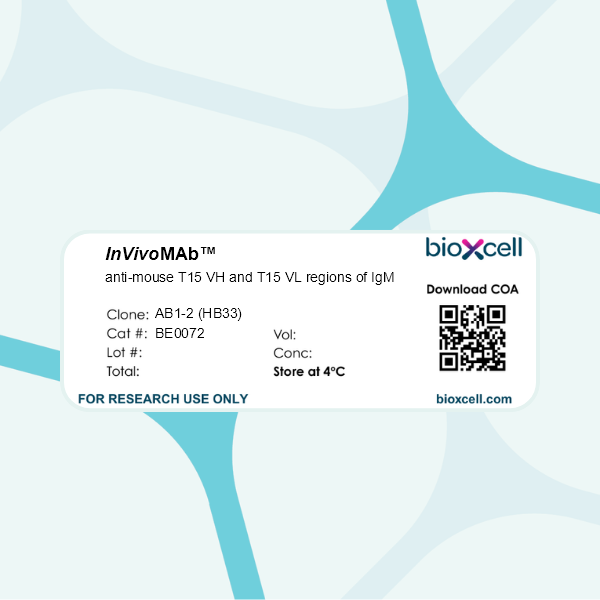InVivoMAb anti-mouse T15 VH and T15 VL regions of IgM
Product Description
Specifications
| Isotype | Mouse IgG1, κ |
|---|---|
| Recommended Isotype Control(s) | InVivoMAb mouse IgG1 isotype control, unknown specificity |
| Recommended Dilution Buffer | InVivoPure pH 7.0 Dilution Buffer |
| Conjugation | This product is unconjugated. Conjugation is available via our Antibody Conjugation Services. |
| Immunogen | Purified antibodies from MOPC 460, MOPC 5558, and HOPC 8 myelomas |
| Reported Applications | ELISA |
| Formulation |
PBS, pH 7.0 Contains no stabilizers or preservatives |
| Endotoxin |
≤1EU/mg (≤0.001EU/μg) Determined by LAL assay |
| Purity |
≥95% Determined by SDS-PAGE |
| Sterility | 0.2 µm filtration |
| Production | Purified from cell culture supernatant in an animal-free facility |
| Purification | Protein G |
| RRID | AB_1125545 |
| Molecular Weight | 150 kDa |
| Storage | The antibody solution should be stored at the stock concentration at 4°C. Do not freeze. |
| Need a Custom Formulation? | See All Antibody Customization Options |
Application References
ELISA
Zhao, W., et al (2015). "Macrophage-specific overexpression of interleukin-5 attenuates atherosclerosis in LDL receptor-deficient mice" Gene Ther 22(8): 645-652.
PubMed
Interleukin-5 (IL-5) increases the secretion of natural T15/EO6 IgM antibodies that inhibit the uptake of oxidized low-density lipoprotein (LDL) by macrophages. This study aimed to determine whether macrophage-specific expression of IL-5 in LDL receptor-deficient mice (Ldlr(-/-)) could improve cholesterol metabolism and reduce atherosclerosis. To induce macrophage-specific IL-5 expression, the pLVCD68-IL5 lentivirus was delivered into Ldlr(-/-) mice via bone marrow transplantation. The recipient mice were fed a Western-type diet for 12 weeks to induce lesion formation. We found that IL-5 was efficiently and specifically overexpressed in macrophages in recipients of pLVCD68-IL5-transduced bone marrow cells (BMC). Plasma titers of T15/EO6 IgM antibodies were significantly elevated by 58% compared with control mice transplanted with pLVCD68 lacking the IL-5 coding sequence. Plaque areas of aortas in IL-5-overexpressing mice were reduced by 43% and associated with a 2.4-fold decrease in lesion size at the aortic roots when compared with mice receiving pLVCD68-transduced BMCs. The study showed that macrophage-specific overexpression of IL-5 inhibited the progression of atherosclerotic lesions. These findings suggest that modulation of IL-5 cytokine expression represents a potential strategy for intervention of familial hypercholesterolemia and other cardiovascular diseases.
Product Citations
-
-
Enzyme-linked immunosorbent assay
-
Mus musculus (Mouse)
-
Genetics
-
Immunology and Microbiology
Enhancer-instructed epigenetic landscape and chromatin compartmentalization dictate a primary antibody repertoire protective against specific bacterial pathogens.
In Nat Immunol on 1 February 2023 by Barajas-Mora, E. M., Lee, L., et al.
PubMed
Antigen receptor loci are organized into variable (V), diversity (D) and joining (J) gene segments that rearrange to generate antigen receptor repertoires. Here, we identified an enhancer (E34) in the murine immunoglobulin kappa (Igk) locus that instructed rearrangement of Vκ genes located in a sub-topologically associating domain, including a Vκ gene encoding for antibodies targeting bacterial phosphorylcholine. We show that E34 instructs the nuclear repositioning of the E34 sub-topologically associating domain from a recombination-repressive compartment to a recombination-permissive compartment that is marked by equivalent activating histone modifications. Finally, we found that E34-instructed Vκ-Jκ rearrangement was essential to combat Streptococcus pneumoniae but not methicillin-resistant Staphylococcus aureus or influenza infections. We propose that the merging of Vκ genes with Jκ elements is instructed by one-dimensional epigenetic information imposed by enhancers across Vκ and Jκ genomic regions. The data also reveal how enhancers generate distinct antibody repertoires that provide protection against lethal bacterial infection.
-
-
-
Immunology and Microbiology
Combined PD-L1 and TIM-3 blockade improves the expansion of fit human CD8+ antigen-specific T cells for adoptive immunotherapy
In medRxiv on 2 September 2021 by Lak, S., Janelle, V., et al.
-

